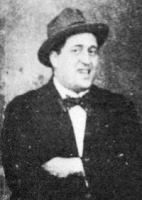| 纪尧姆·阿波利奈尔 | |||||
阅读阿波里奈尔 Guillaume Apollinaire在诗海的作品!!! | |||||
Among the foremost poets of the early 20th century, he is credited with coining the word surrealism and writing one of the earliest works described as surrealist, the play Les Mamelles de Tirésias (1917, later used as the basis for an opera in 1947).
Two years after being wounded in World War I, he died at 38 of the Spanish flu during a pandemic.
Born Wilhelm Albert Vladimir Apollinaris Kostrowitzky / Wąż-Kostrowicki and raised speaking French, among other languages, he emigrated to France and adopted the name Guillaume Apollinaire. His mother, born Angelica Kostrowicka, was a Polish noblewoman born near Navahrudak (now in Belarus). His father is unknown but may have been Francesco Flugi d'Aspermont, a Swiss Italian aristocrat who disappeared early from Apollinaire's life. He was partly educated in Monaco.
Apollinaire was one of the most popular members of the artistic community of Montparnasse in Paris. His friends and collaborators during that period included Pablo Picasso, Gertrude Stein, Max Jacob, André Salmon, Marie Laurencin, André Breton, André Derain, Faik Konica, Blaise Cendrars, Pierre Reverdy, Jean Cocteau, Erik Satie, Ossip Zadkine, Marc Chagall and Marcel Duchamp. In 1911, he joined the Puteaux Group, a branch of the cubist movement.
On September 7, 1911, police arrested and jailed him on suspicion of stealing the Mona Lisa, but released him a week later. Apollonaire then implicated his friend Pablo Picasso, who was also brought in for questioning in the art theft, but he was also exonerated.
He fought in World War I and, in 1916, received a serious shrapnel wound to the temple (see photo). He wrote Les Mamelles de Tirésias while recovering from this wound. During this period he coined the word surrealism in the program notes for Jean Cocteau and Erik Satie's ballet Parade, first performed on 18 May 1917. He also published an artistic manifesto, L'Esprit nouveau et les poètes. Apollinaire's status as a literary critic is most famous and influential in his recognition of the Marquis de Sade, whose works were for a long time obscure, yet arising in popularity as an influence upon the Dada and Surrealist art movements going on in Montparnasse at the beginning of the twentieth century as, "The freest spirit that ever existed."
The war-weakened Apollinaire died of influenza during the Spanish Flu pandemic of 1918. He was interred in the Le Père Lachaise Cemetery, Paris.
Works
Apollinaire's first collection of poetry was L'enchanteur pourrissant (1909), but Alcools (1913) established his reputation. The poems, influenced in part by the Symbolists, juxtapose the old and the new, combining traditional poetic forms with modern imagery. In 1913, Apollinaire published the essay Les Peintres cubistes on the cubist painters, a movement which he helped to define. He also coined the term orphism to describe a tendency towards absolute abstraction in the paintings of Robert Delaunay and others.
In 1907, Apollinaire wrote the well-known erotic novel, The Eleven Thousand Rods (Les Onze Mille Verges). Officially banned in France until 1970, various printings of it circulated widely for many years. Apollinaire never publicly acknowledged authorship of the novel. Another erotic novel attributed to him was The Exploits of a Young Don Juan (Les exploits d'un jeune Don Juan), in which the 15-year-old hero fathers three children with various members of his entourage, including his aunt. The book was made into a movie in 1987.
Shortly after his death, Calligrammes, a collection of his concrete poetry (poetry in which typography and layout adds to the overall effect), was published.
In his youth Apollinaire lived for a short while in Belgium, but mastered the Walloon language sufficiently to write poetry through that medium, some of which has survived.
Selected bibliography
Henri Rousseau, "La Muse inspirant le poète," 1909. (A portrait of Apollinaire and Marie Laurencin).
Poetry
Le bestiaire ou le cortège d’Orphée, 1911
Alcools, 1913
Vitam impendere amori', 1917
Calligrammes, poèmes de la paix et de la guerre 1913-1916, 1918 (published shortly after Apollinaire's death)
Il y a..., 1925
Ombre de mon amour, poems addressed to Louise de Coligny-Châtillon, 1947
Poèmes secrets à Madeleine, pirated edition, 1949
Le Guetteur mélancolique, previously unpublished works, 1952
Poèmes à Lou, 1955
Soldes, previously unpublished works, 1985
Et moi aussi je suis peintre, album of drawings for Calligrammes, from a private collection, published 2006
Prose
Mirely ou le Petit Trou pas cher, 1900
"Que faire?",
Les Onze Mille Verges ou les amours d'un hospodar, 1907
L'enchanteur pourrissant, 1909
L'Hérèsiarque et Cie (short story collection), 1910
Les exploits d’un jeune Don Juan, 1911
La Rome des Borgia, 1914
La Fin de Babylone - L'Histoire romanesque 1/3, 1914
Les Trois Don Juan - L'Histoire romanesque 2/3, 1915
Le poète assassiné, 1916
La femme assise, 1920
Les Épingles (short story collection), 1928
Plays and screenplays
Les Mamelles de Tirésias, play, 1917
La Bréhatine, screenplay (collaboration with André Billy), 1917
Couleurs du temps, 1918
Casanova, published 1952
Articles, essays, etc.
Le Théâtre Italien, illustrated encyclopedia, 1910
Pages d'histoire, chronique des grands siècles de France, chronicles, 1912
Méditations esthétiques. Les peintres cubistes, 1913
La Peinture moderne, 1913
L'Antitradition futuriste, manifeste synthèse, 1913
Case d'Armons, 1915
L'esprit nouveau et les poètes, 1918
Le Flâneur des Deux Rives, chronicles, 1918
References
^ Time Magazine, STEALING THE MONA LISA, 1911. Consulted on August 15, 2007.
Additional references
Apollinaire, Marcel Adéma, 1954
Apollinaire, Poet among the Painters, Francis Steegmuller, 1963, 1971, 1973
Apollinaire, M. Davies, 1964
Guillaume Apollinaire, S. Bates, 1967
Guillaume Apollinaire, P. Adéma, 1968
The Banquet Years, Roger Shattuck, 1968
Apollinaire, R. Couffignal, 1975
Guillaume Apollinaire, L.C. Breuning, 1980
Reading Apollinaire, T. Mathews, 1987
Guillaume Apollinaire, J. Grimm, 1993
